Autumn in the garden year: the hours of sunshine become significantly less, but the humidity increases and the temperatures drop. At night, sometimes even to below zero degrees Celsius. To prepare the garden for the new season and thus guarantee that the flowers and shrubs bloom again in full splendor next year, we have tips for you.
Contents
Maintaining the lawn in autumn
Prepare your lawn now for the wet, sunless season. It is therefore important to let the lawn breathe again. Rake off leaves, moss and fallen, dead plant parts from your lawn. Autumn and spring are the times to dethatch again. Keep in mind that the turf will be stressed a bit, so don’t scarify the lawn too deeply, it won’t have as much time to recover in the following weeks as it did in spring. Especially autumn fertilizers can additionally strengthen your green.
When scarifying like fertilizing, it should rain soon after the work to support the area with moisture. Do not stress the area much more, otherwise you may have to wait half a year until a new greening. Also mow the lawn in the fall, but no longer too short (at least 5 centimeters in length). All tips for lawn care in autumn
Perennials, shrubs and trees in autumn: time for pruning
Now is the best time to make necessary pruning on perennials, shrubs and trees. Especially dead and diseased branches and plant parts are removed, plant cut back for rejuvenation. For example, as soon as the asters (see picture above) have faded, cut back the perennial.
Do not cut too radically too late in the year: on the one hand, healthy branches are a protection for the plant and its root, on the other hand, otherwise the garden will look bare in the following months. Cut back the hedge again if necessary, but again, too extreme pruning will provide less privacy in the winter.
Move larger plants now
In addition to pruning work, fall is a good time to move plants around the garden. Be careful not to damage the roots, so dig up the shrubs or trees generously. Then water the newly planted plant intensively, so that it starts well in the new place. Therefore, these actions should also not be done too late in the fall, not that frost and cold affect the plant. For frost-sensitive plants, wait until spring.
Grasses, on the contrary, leave even in winter, they not only look beautiful in winter, but also provide shelter for animals. It is also a good idea to store the leaves in a quiet corner of the garden, as this also helps animals to hibernate. Part of the leaves can also be put on the compost.

Loosen up the bed, mulch, set early bloomers.
From the flower beds should be cut off withered plants. Take the opportunity to loosen the soil so that water drains better and reaches the roots. Winter-hardy plants that remain in the ground, protect them with mulch substrate. Place the bulbs of early bloomers, such as crocuses, tulips and daffodils, in the beds. Dig up the bulbs of summer flowers, such as begonias, dahlias, gladioli, and store them in a box in the basement, protected from frost.
Potted plants and balcony plants, such as oleanders or fuchsias and geraniums are also brought indoors and placed in a cool but frost-proof place. Cold-sensitive, especially Mediterranean perennials and herbs that are to overwinter in the garden, cover thoroughly with branches or provide additional protection with a fleece.
If sunflowers have bloomed in your garden, collect the seeds and save them for birdseed or as seeds for next year.
In advanced fall, when night frost is an issue, also take care of work around the house and your garden tools – more on that here: How to winterize your garden.


